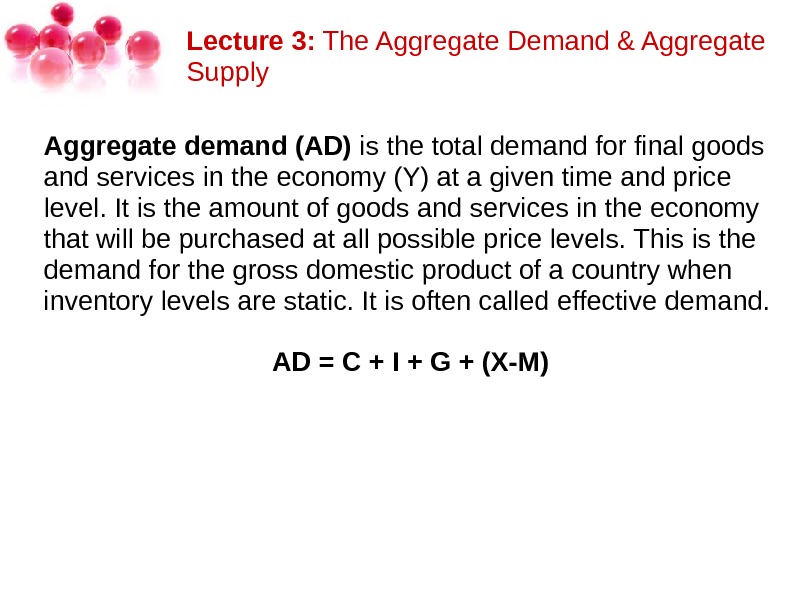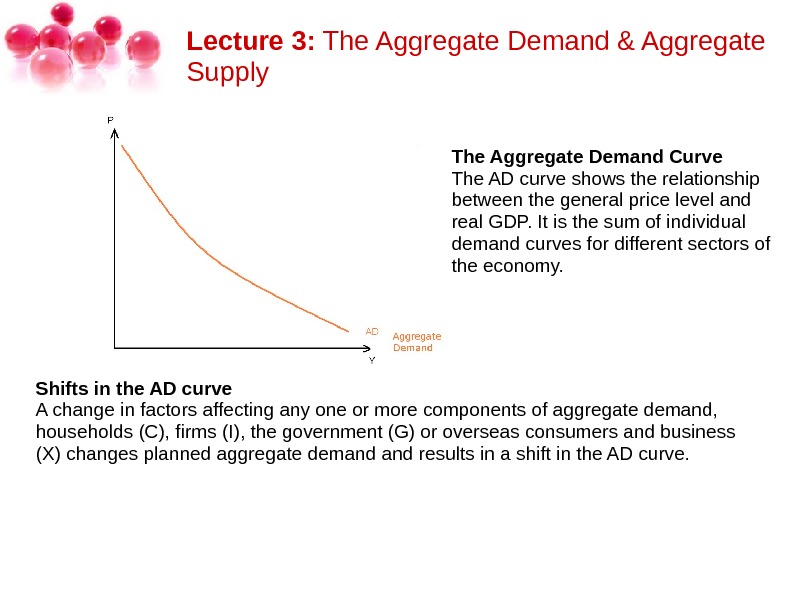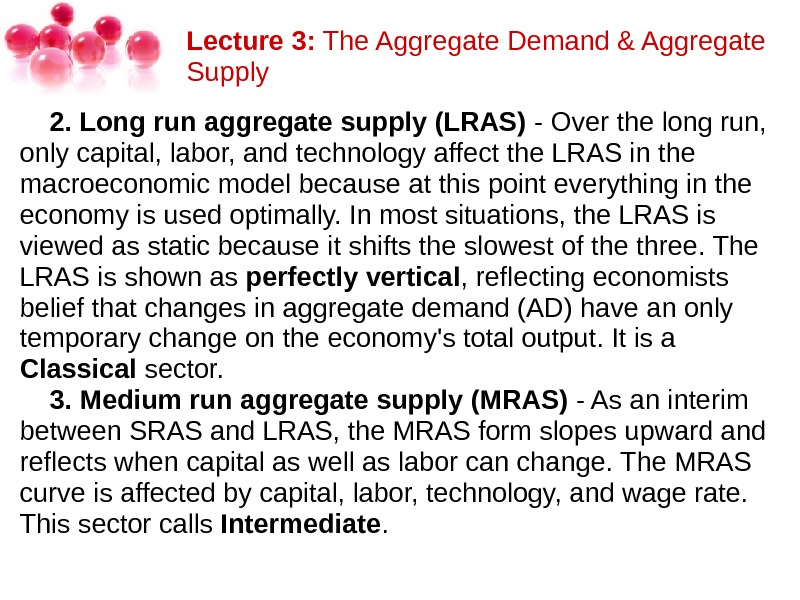Lecture 3 TheAggregateDemand &AggregateSupply Lecture 3:















lecture_3_the_aggregate_demand_aggregate_s.ppt
- Размер: 398.5 Кб
- Количество слайдов: 14
Описание презентации Lecture 3 TheAggregateDemand &AggregateSupply Lecture 3: по слайдам
 Lecture 3 The. Aggregate. Demand &Aggregate. Supply
Lecture 3 The. Aggregate. Demand &Aggregate. Supply
 Lecture 3: The. Aggregate. Demand&Aggregate Supply 1. Aggregate Demand. 2. Aggregate Supply. 3. The Aggregate Demand-Aggregate Supply Model.
Lecture 3: The. Aggregate. Demand&Aggregate Supply 1. Aggregate Demand. 2. Aggregate Supply. 3. The Aggregate Demand-Aggregate Supply Model.
 Lecture 3: The. Aggregate. Demand&Aggregate Supply Inventory – запаси Overheating– перегрів(економіки)
Lecture 3: The. Aggregate. Demand&Aggregate Supply Inventory – запаси Overheating– перегрів(економіки)
 Lecture 3: The. Aggregate. Demand&Aggregate Supply Aggregate demand (AD) isthetotaldemandforfinalgoods andservicesintheeconomy(Y)atagiventimeandprice level. Itistheamountofgoodsandservicesintheeconomy thatwillbepurchasedatallpossiblepricelevels. Thisisthe demandforthegrossdomesticproductofacountrywhen inventorylevelsarestatic. Itisoftencalledeffectivedemand. AD = C + I + G + (X-M)
Lecture 3: The. Aggregate. Demand&Aggregate Supply Aggregate demand (AD) isthetotaldemandforfinalgoods andservicesintheeconomy(Y)atagiventimeandprice level. Itistheamountofgoodsandservicesintheeconomy thatwillbepurchasedatallpossiblepricelevels. Thisisthe demandforthegrossdomesticproductofacountrywhen inventorylevelsarestatic. Itisoftencalledeffectivedemand. AD = C + I + G + (X-M)
 Lecture 3: The. Aggregate. Demand&Aggregate Supply The Aggregate Demand Curve The. ADcurveshowstherelationship betweenthegeneralpriceleveland real. GDP. Itisthesumofindividual demandcurvesfordifferentsectorsof theeconomy. Shifts in the AD curve Achangeinfactorsaffectinganyoneormorecomponentsofaggregatedemand, households(C), firms(I), thegovernment(G)oroverseasconsumersandbusiness (X)changesplannedaggregatedemandandresultsinashiftinthe. ADcurve.
Lecture 3: The. Aggregate. Demand&Aggregate Supply The Aggregate Demand Curve The. ADcurveshowstherelationship betweenthegeneralpriceleveland real. GDP. Itisthesumofindividual demandcurvesfordifferentsectorsof theeconomy. Shifts in the AD curve Achangeinfactorsaffectinganyoneormorecomponentsofaggregatedemand, households(C), firms(I), thegovernment(G)oroverseasconsumersandbusiness (X)changesplannedaggregatedemandandresultsinashiftinthe. ADcurve.
 Lecture 3: The. Aggregate. Demand&Aggregate Supply Factors causing a shift in AD: • Changes in Expectations. Currentspendingisaffectedbyanticipatedfuture income, profit, andinflation. • Changes in Monetary Policy –i. e. achangeininterestrates. Lower interestratesencouragefirmstoborrowandinvest. • Changes in Fiscal Policy. Fiscal. Policyreferstochangesingovernment spending, welfarebenefitsandtaxation, andtheamountthatthe governmentborrows. • Economic events in the international economy. Internationalfactorssuch astheexchangerateandforeignincome(e. g. theeconomiccycleinother countries. ) • Changes in household wealth. Wealthreferstothevalueofassetsowned byconsumerse. g. housesandshares.
Lecture 3: The. Aggregate. Demand&Aggregate Supply Factors causing a shift in AD: • Changes in Expectations. Currentspendingisaffectedbyanticipatedfuture income, profit, andinflation. • Changes in Monetary Policy –i. e. achangeininterestrates. Lower interestratesencouragefirmstoborrowandinvest. • Changes in Fiscal Policy. Fiscal. Policyreferstochangesingovernment spending, welfarebenefitsandtaxation, andtheamountthatthe governmentborrows. • Economic events in the international economy. Internationalfactorssuch astheexchangerateandforeignincome(e. g. theeconomiccycleinother countries. ) • Changes in household wealth. Wealthreferstothevalueofassetsowned byconsumerse. g. housesandshares.
 Lecture 3: The. Aggregate. Demand&Aggregate Supply Aggregate supply isthetotal supplyofgoodsandservices thatfirmsinanational economyplanonsellingduring aspecifictimeperiod. Itisthe totalamountofgoodsand servicesthatfirmsarewillingto sellatagivenpricelevelinan economy. Aggregatesupplyisdeterminedbythesupplyside performanceoftheeconomy. Itreflectstheproductive capacityoftheeconomyandthecostsofproductionineach sector.
Lecture 3: The. Aggregate. Demand&Aggregate Supply Aggregate supply isthetotal supplyofgoodsandservices thatfirmsinanational economyplanonsellingduring aspecifictimeperiod. Itisthe totalamountofgoodsand servicesthatfirmsarewillingto sellatagivenpricelevelinan economy. Aggregatesupplyisdeterminedbythesupplyside performanceoftheeconomy. Itreflectstheproductive capacityoftheeconomyandthecostsofproductionineach sector.
 Lecture 3: The. Aggregate. Demand&Aggregate Supply Therearegenerally three forms of aggregate supply (AS). Theyare: 1. Short run aggregate supply (SRAS) -Withinthetime frameduringwhichfirmscanchangetheamountoflabor usedbutnotcapital(suchasbuildingnewfactories). This formdemonstrateswhathappenstotheeconomywhen resourcesareunderused. Upwardshiftsin. SRASgenerally increaseoutput(Y)butdon’tincreaseprice(P). The. SRAS curveisnearly perfectly horizontal. Italsocalls Keynesian sector. Theconceptisthatwages(priceoflabor)don’t changeovertheshortrun.
Lecture 3: The. Aggregate. Demand&Aggregate Supply Therearegenerally three forms of aggregate supply (AS). Theyare: 1. Short run aggregate supply (SRAS) -Withinthetime frameduringwhichfirmscanchangetheamountoflabor usedbutnotcapital(suchasbuildingnewfactories). This formdemonstrateswhathappenstotheeconomywhen resourcesareunderused. Upwardshiftsin. SRASgenerally increaseoutput(Y)butdon’tincreaseprice(P). The. SRAS curveisnearly perfectly horizontal. Italsocalls Keynesian sector. Theconceptisthatwages(priceoflabor)don’t changeovertheshortrun.
 Lecture 3: The. Aggregate. Demand&Aggregate Supply 2. Long run aggregate supply (LRAS) -Overthelongrun, onlycapital, labor, andtechnologyaffectthe. LRASinthe macroeconomicmodelbecauseatthispointeverythinginthe economyisusedoptimally. Inmostsituations, the. LRASis viewedasstaticbecauseitshiftstheslowestofthethree. The LRASisshownas perfectly vertical , reflectingeconomists beliefthatchangesinaggregatedemand(AD)haveanonly temporarychangeontheeconomy’stotaloutput. Itisa Classical sector. 3. Medium run aggregate supply (MRAS) -Asaninterim between. SRASand. LRAS, the. MRASformslopesupwardand reflectswhencapitalaswellaslaborcanchange. The. MRAS curveisaffectedbycapital, labor, technology, andwagerate. Thissectorcalls Intermediate.
Lecture 3: The. Aggregate. Demand&Aggregate Supply 2. Long run aggregate supply (LRAS) -Overthelongrun, onlycapital, labor, andtechnologyaffectthe. LRASinthe macroeconomicmodelbecauseatthispointeverythinginthe economyisusedoptimally. Inmostsituations, the. LRASis viewedasstaticbecauseitshiftstheslowestofthethree. The LRASisshownas perfectly vertical , reflectingeconomists beliefthatchangesinaggregatedemand(AD)haveanonly temporarychangeontheeconomy’stotaloutput. Itisa Classical sector. 3. Medium run aggregate supply (MRAS) -Asaninterim between. SRASand. LRAS, the. MRASformslopesupwardand reflectswhencapitalaswellaslaborcanchange. The. MRAS curveisaffectedbycapital, labor, technology, andwagerate. Thissectorcalls Intermediate.
 Lecture 3: The. Aggregate. Demand&Aggregate Supply Shifts in the AS curve can be caused by the following factors: • Changesinsize&qualityofthe labour force availableforproduction. • Changesinsize&qualityof capital stock throughinvestment. • Technological progress andtheimpactof innovation. • Changesin factor productivity ofbothlabourandcapital. • Changesin unit wage costs (wagecostsperunitofoutput. ) • Changesinproducer taxes and subsidies. • Changesin inflation expectations -ariseininflationexpectationsislikelyto boostwagelevelsandcause. AStoshiftinwards.
Lecture 3: The. Aggregate. Demand&Aggregate Supply Shifts in the AS curve can be caused by the following factors: • Changesinsize&qualityofthe labour force availableforproduction. • Changesinsize&qualityof capital stock throughinvestment. • Technological progress andtheimpactof innovation. • Changesin factor productivity ofbothlabourandcapital. • Changesin unit wage costs (wagecostsperunitofoutput. ) • Changesinproducer taxes and subsidies. • Changesin inflation expectations -ariseininflationexpectationsislikelyto boostwagelevelsandcause. AStoshiftinwards.
 Lecture 3: The. Aggregate. Demand&Aggregate Supply The AD-AS or Aggregate Demand-Aggregate Supply model isamacroeconomicmodelthatexplainspricelevel andoutputthroughtherelationshipofaggregatedemandand aggregatesupply. Itwasfirstputforthby John Maynard Keynes inhiswork The. General. Theoryof. Employment, Interest, and. Money. The. AD-ASmodelisusedtoillustratethe. Keynesian modelofthebusinesscycle. Movementsofthetwocurves canbeusedtopredicttheeffectsthatvariousexogenous eventswillhaveontwovariables: real. GDPandtheprice level.
Lecture 3: The. Aggregate. Demand&Aggregate Supply The AD-AS or Aggregate Demand-Aggregate Supply model isamacroeconomicmodelthatexplainspricelevel andoutputthroughtherelationshipofaggregatedemandand aggregatesupply. Itwasfirstputforthby John Maynard Keynes inhiswork The. General. Theoryof. Employment, Interest, and. Money. The. AD-ASmodelisusedtoillustratethe. Keynesian modelofthebusinesscycle. Movementsofthetwocurves canbeusedtopredicttheeffectsthatvariousexogenous eventswillhaveontwovariables: real. GDPandtheprice level.
 Lecture 3: The. Aggregate. Demand&Aggregate Supply Inthemodel. AD-ASwe canobserve two types of equilibrium : 1. Real equilibrium. In thiscase, equilibriumis reachedwhenaggregate demandequalsaggregate supplyintheshortterm. Thepointofintersectionoftwocurvesformstwoequilibriumvalues: generalpricelevelandaggregateoutput. Whenshiftingoneofthese twographs, theequilibriumpointisshiftedaccordingtotheoneofthe curves, formingnewequilibriumparametersoftheeconomy.
Lecture 3: The. Aggregate. Demand&Aggregate Supply Inthemodel. AD-ASwe canobserve two types of equilibrium : 1. Real equilibrium. In thiscase, equilibriumis reachedwhenaggregate demandequalsaggregate supplyintheshortterm. Thepointofintersectionoftwocurvesformstwoequilibriumvalues: generalpricelevelandaggregateoutput. Whenshiftingoneofthese twographs, theequilibriumpointisshiftedaccordingtotheoneofthe curves, formingnewequilibriumparametersoftheeconomy.
 Lecture 3: The. Aggregate. Demand&Aggregate Supply 2. Potential equilibrium. Thiskindofequilibriumshows thatmightbethelevelofprices andoutputofgoodsatfull employmentofalleconomic resources. Iftherealbalanceexceedsthepotential, i. e. thelong-runsupplycurve isontherightsideofthepointofarealbalance, (then)wecantalk about recession , becausetheresourcesareusedinefficientlyand incompletely. Iftherealbalanceexceedsthepotential, therefore, we cantalkabouteconomic overheating , becauseofover-employmentof resources.
Lecture 3: The. Aggregate. Demand&Aggregate Supply 2. Potential equilibrium. Thiskindofequilibriumshows thatmightbethelevelofprices andoutputofgoodsatfull employmentofalleconomic resources. Iftherealbalanceexceedsthepotential, i. e. thelong-runsupplycurve isontherightsideofthepointofarealbalance, (then)wecantalk about recession , becausetheresourcesareusedinefficientlyand incompletely. Iftherealbalanceexceedsthepotential, therefore, we cantalkabouteconomic overheating , becauseofover-employmentof resources.
 Fin
Fin

